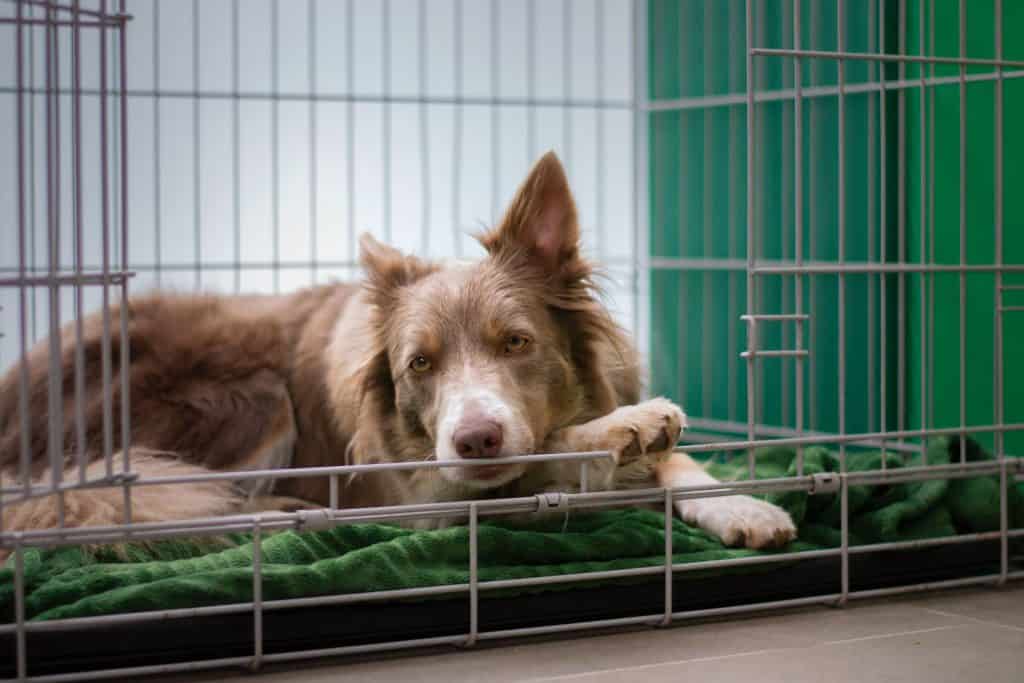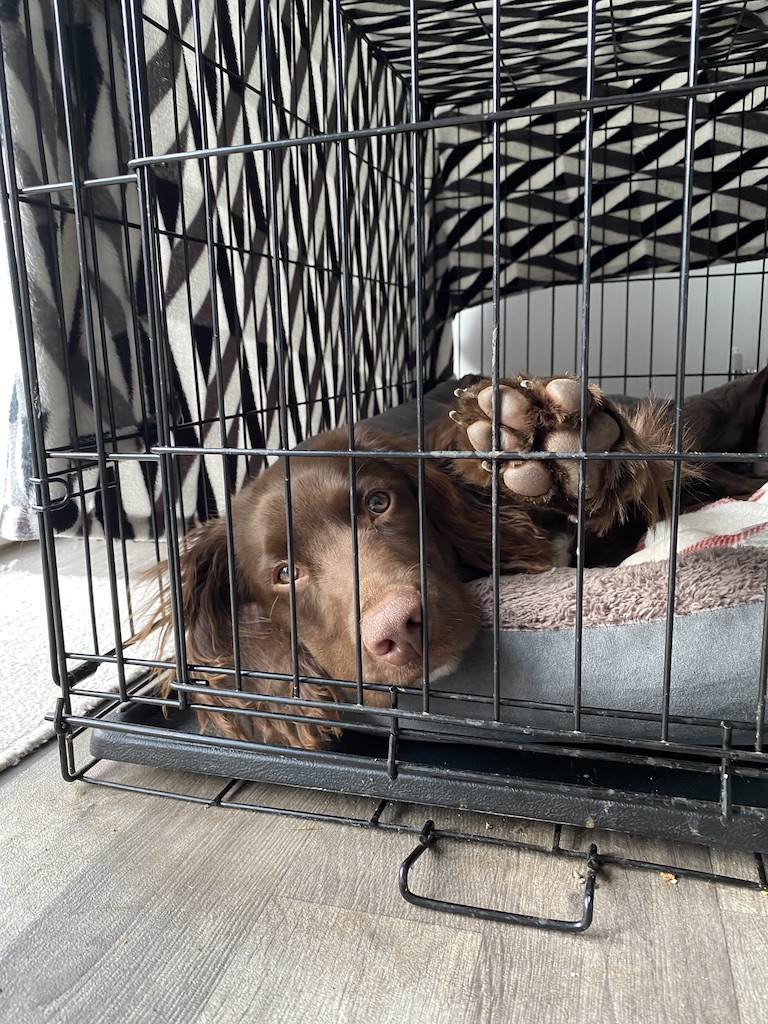Dogs are den animals and have been for many centuries.
While some humans may see a crate as a mini prison, dogs find comfort in having their own small den-like space. A crate or a kennel offers many benefits for both your dog and you, as it serves as a powerful training tool and a calm place for your dog to go if they feel the need.
This post contains affiliate links. Please read my full disclosure here.
Why crate train your Spaniel?
Like all other dogs, Spaniels are den animals. Just like dogs are genetically programmed to hunt for their food through sniffing and chasing, they are programmed to find comfort in small, enclosed spaces instinctively.
Crates offer a safe place for your dog to sleep where they will avoid feelings of anxiety and feel secure and confident in their home.
Offering a place that feels natural and secure can help your dog to learn to self-soothe in high-anxiety situations, such as uncommon guests, fireworks, celebrations, and thunderstorms.
Crate training is essential for housebreaking, creating good sleep habits, and offering a quiet place away from potential excitement in the home. In addition, a crate-trained Spaniel is better equipped to handle moving and boarding in new or unexpected places in an emergency.
Finally, offering your dog a crate allows for a schedule or reliable system to be established. Your dog’s crate should be a place of calmness and limited to just your dog. No children or other animals should be allowed in or on the crate to maintain this security.
The best crate for Spaniels
To successfully crate train your pup, you will need to find the crate that is the right size and material for your needs. When choosing a crate, it is essential to find the size that will best fit your Spaniel at its adult size unless you plan to size up the crate as your dog grows.
A crate should be big enough to allow your dog to stand up, turn around, and lay down, but not too big as too much space may result in accidents.
Experts suggest measuring your pup from nose to tail and adding 2-4 inches. Here are recommended crate sizes for Spaniels:
- King Charles Cavalier Spaniel: Small crate
- Sprocker and Cocker Spaniel: Medium crate
- English Springer Spaniel: Medium to large crate
How to crate train your Spaniel
1. Get them engaging with the crate
When you choose to crate train your spaniel, you are offering your dog a safe and calm place that is its own. Ease the transition to crate training by introducing your dog to the crate in a calm manner, avoiding using the crate as punishment.
Introduce your pup to the crate by sitting together with them outside with the door open. Particularly sensitive to tone, Spaniels are eager to please their human counterparts. Gently pet them and talk to them in a positive, soft, calming manner. You may choose to offer a few of your dog’s favorite treats to build positive association.
Read more: 7 Training Games to Keep Your Spaniel Puppy Entertained
2. Reward entry to the crate
Once your pup seems comfortable around the crate, let them explore inside if they choose. Do not shut them in just yet.
If your pup is more hesitant, try placing a few treats just outside the door, then a few just inside. If your pup steps in, reward them with plenty of praise and a treat. As they get more comfortable, toss yummy dog treats further back into the crate until your dog seems confident and comfortable.
Before locking your pup in for the first time, this exercise should be completed several times to ensure they are confident and comfortable with their new den. Many dogs enjoy a comfortable bed or blanket on the floor.

3. Practice closing the door
Once your puppy is comfortable inside the crate, it is time to close the door.
Begin with short increments of time, serving treats inside the crate, closing the door as your dog eats, and opening it as they finish. Slowly increase this time inside the closed crate with you in close view. Each time your pup spends inside the closed crate should be met with plenty of praise and love.
You may also choose to feed your puppy inside their crate. Offering food in this place of comfort helps to confirm the crate as a positive area where good things happen. Just be sure to supervise them at all times.
4. Continue praise over time
Over time, decrease the treats offer to your Spaniel as they enter the crate. Replace treats with lots of praise. When your spaniel is comfortable entering and staying in their crate, they will be happy to oblige to your requests and commands.
Some pups take to crate training quickly and find comfort in their modern-day dens within days, while others may take a bit more coaxing. But, with enough praise and support, your spaniel will love spending quiet time in their bed.
Read more: 10 Essential Spaniel Training Commands to Teach Your Puppy
Never use crates as punishment
Just like anything else, there can be too much of a good thing. Dogs, particularly those with higher energy levels like spaniels, need time and space to release their energy. So while a crate is a great resource and safe haven for your dog, it should not be used for extended periods.
All types of Spaniel are particularly sensitive breeds that learn better with positive reinforcement. This breed does not learn well from punishments or stress.
In order to set you and your pup up for crate-training success, it is vital to approach training positively and avoid using the crate as a punishment or a stressful area.
Your dog’s crate will become a safe place for them to go when they feel anxious or stressed.
Therefore, it is important to place this crate somewhere easily accessible and keep it there to the best of your ability. A crate should not be placed in a high-stress area and should not be moved unless necessary.
It can be helpful to encourage your dog to go into their crate throughout the day. For example, if you plan only to crate your dog while you are out of the house, your pup may learn that the crate means you will be leaving the house. This association may lead to increased stress or separation anxiety. Even if it is just for a few minutes here and there throughout the day, you should encourage your spaniel to go into their crate.
Do you crate train your Spaniel?
Crate training can be difficult for some and second-nature to others. However, any dog can find solace in its den-like area.
Creating a safe and stress-free zone for your dog has numerous benefits for both you and your four-legged friend. While training may seem like a large feat to overcome, the rewards far outweigh the potential struggle and offer a training experience that the family can work together to bond over.


